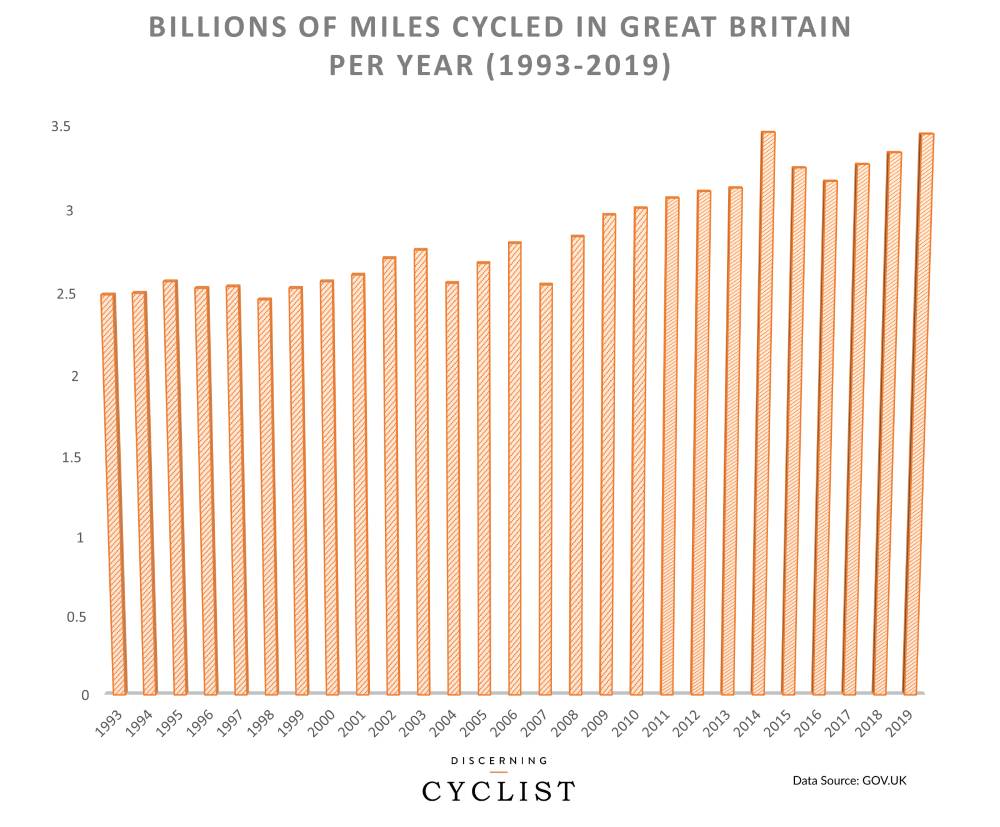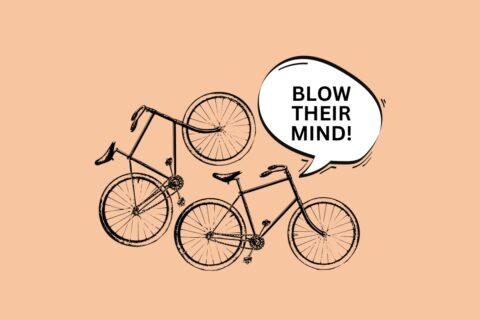This post may contain affiliate links, which help to keep Discerning Cyclist rolling. Learn more.
If the beginning of the COVID-19 pandemic in 2020 left us all mentally, emotionally drained, it felt almost impossible to find any silver lining in these dark clouds.
But there was at least one positive from a cycling perspective: it seemed to trigger a ‘bike boom.’

The Bike Boom of 2020
As coronavirus ravaged the planet, we had pop-up bike lines appearing everywhere, as many as 8.9 million people in the UK cycling per week during the pandemic’s early months, and bike repair voucher schemes introduced by the British government, too.
And it wasn’t just outdoor cycling that saw a surge in popularity. Indoor cycling-focussed apps and services such as Peloton experienced enormous growth in 2020, going from less than 700,000 paying customers at the start of the year to over 3 million by the end of it.
So, why has cycling become so popular again so quickly? What has happened to bike sales during COVID? And will the bike boom last? Let’s explore all of this and more:
Why Has Cycling Become More Popular?
Well, fewer people took public transport to help alleviate the spread of COVID-19, and used cycling as a healthier means of transportation – either getting to work or just riding for pleasure – but also to shrug off cabin fever caused by the constant ‘Stay At Home’ government messages.
Why has cycling increased in popularity other than general anxiety towards buses and trains? Well, add that to the fact that more exercise can improve your immune system, which in turn gives your body a better chance of fighting coronavirus if you contract it, and cycling ultimately became a craze again all over the world.
“People were at home with nothing to do, a bike sitting in their garage with flat tires.
“One of the barriers to bicycling across the ages is anxiety about a thing with 100 moving parts: people worry, ‘How do I store it? How do I fix it?’ But lockdown changed that. Suddenly, everyone had the time to tinker.”
Morgan Lommele, director of state policy at People for Bikes.
Cycling Statistics During COVID-19
- An enormous $4.1 billion worth of bikes (excluding e-bikes) were sold in the US between January and October 2020, a 62% increase on the same period a year earlier.
- E-bikes, meanwhile, raked in $490.8 million in US sales, a 144% growth on the previous year.
- One in 10 American adults were reported to having rode a bike for the first time in a year (or longer) since the beginning of COVID-19.
- China exported more than 40 million bikes in the first nine months of 2020 – that’s four times the EU’s annual bike production.
- According to Eco-Counter, who have tracked monthly cycling levels globally in 2020 and comparing them to last year’s figures, these were up in September 2020 by 27.5% in Italy, 25.3% in Portugal, 24.5% in France and 20% in the UK and Germany respectively compared to September 2019.
- Cycling trips clocked into Strava increased by 56% in Berlin in April 2020 compared to April 2019, by 82% in Barcelona between June 2019 and June 2020, by 119% in London between May 2019 and May 2020, and by 222% in Liverpool during the same period.
- Cycling in Polish cities has increased by 50% according to the draft national Recovery and Resilience Plan. This has caused the government to feature cycling projects prominently in their plans – 14 of the 16 Polish regions have submitted cycling-related proposals, as such.
- VanMoof, a Dutch e-bike maker, saw ‘unlimited demand’ in the early months of the pandemic, causing a ten-week order backlog for its commuter electric bikes, compared with typical one-day delivery time, said its co-founder Taco Carlier.
You can check out more jaw-dropping statistics of the 2020 bike boom here.
Has Cycling Increased in the UK?
Absolutely. Firstly, take a look at this graph, which shows use of each transport mode compared to use 12 months earlier in the UK:

As you can see, the only form of transport to have increased in usage in this time frame in the UK is cycling, though there has been a slight fall below the previous year in the recent winter months.
That is reflected in the early figures, in particular: from early April to mid-May 2020, during the UK’s first national lockdown, as much as 16% of England’s population (8.9 million) had been cycling each week during the pandemic.
And tellingly, even when restrictions were loosened in June, bicycle traffic in London was believed to be up by 90% based on Google Maps data.
“Despite fewer people travelling over the last few weeks during this crisis, we’ve actually seen around a 100% increase in weekday cycling and at weekends that increase has been up to 200%, compared to the pre COVID-19 levels.
“We want to use this recovery to permanently change the way we travel, with huge levels of investment.”
UK Transport Secretary Grant Shapps, June 2020.
It’s not just England that has seen cycling soar in the UK, either – in Scotland, it was reported in late April 2020 that journeys made by bike had risen by 120% since the pandemic, while bus, rail, ferry, plane and car journeys had fallen by 95%.
Why is there a Bike Shortage?
Indeed, it’s not just toilet paper that’s been flying off the shelves at exponential rates during the pandemic – it’s bikes, too.
Both larger bike stores and independent, smaller shops saw demand go way beyond their projections last spring. And while sales in the US, for instance were up 120% on the previous year, many places just didn’t have the stock to maintain it.
It’s even predicted that a shortage of bikes and/or bike parts may last until 2022.
This is pretty self-explanatory. Given the unexpected and ‘unprecedented’ nature of the last 12 months or so, bike shops could be forgiven for not anticipating such a surge in sales, and thus for not having enough supplies to match the demand.
“It’s come to a point where… everyone has realised we’re running out. There are no bikes to go around anymore.”
Amy Schweiger, assistant manager at Oxygen Bike Co. in Toronto.
“If a customer were to order a new bike today, the earliest we would likely receive it is December and maybe even as late as May.
“We just got a shipment of 60 Treks this week. Most are already spoken for, and the rest will probably be gone before the weekend is over.”
Jimmy Revard, co-owner of ‘The Bike Line’, September 2020.
“We saw the lockdown coming months before it happened, because many of our suppliers are in Asia.
“What we weren’t prepared for was the speed at which it hit.”
Will Butler-Adams, managing director of Brompton Bikes.
Investment in Cycling Infrastructure
Certainly, the advent of greater bike lanes, however temporary they may be, has made riding a bike seem a safer, more viable proposition to many more cycling novices.
For instance, temporary lanes introduced in Westminster, London last May surely contributed to cycling levels reaching ten times the level they were at before lockdown.
London was far from alone, either. Paris created hundreds of kilometres of pop-up lanes along the Rue du Rivoli, while in Germany, local authorities in Berlin’s Kreuzberg district implemented a temporary widening of two cycling lanes in March 2020 to help cyclists keep the necessary 1.5 metres apart.
Elsewhere, in Budapest, cycling lanes led to bus passenger numbers falling by 90% and car travel halving, and Bogota, the capital of Colombia, created 72 miles of new bike routes by mid-March 2020.
Will it Last? The Bike Boom Legacy
New infrastructure will certainly help in this regard. If there’s more – and better – cycling provision, as well as less traffic, and still a lingering aversion to public transport short-term, then even if the bike boom declines, it should still show an increase on pre-COVID times.
But recent figures suggest that the early momentum is unlikely to be rediscovered, in truth.
For example, bike stocks dipped considerably in November 2020 following news that Pfizer had developed a COVID-19 vaccine. Giant fell 9%, Dorel Sports by 7.6%, and bike parts maker Shimano 13.1% in a single day. A month later, those stocks were still trading below their summer peak.
But there is hope from perhaps less obvious sources. Bike share systems are more popular than ever, while electric scooters, offering an even more environmentally-friendly alternative than cars, have risen to greater prominence, too.
The overriding feeling, though, is that continued improvement of infrastructure will be key, or else this current boom will die out just like the 1970s cycling craze did.
“A hundred thousand miles of bikeways were promised across North America. Because they didn’t actually appear, then there [was] nowhere for people to ride their bikes. And so they were put back into garages and then, they were forgotten about, unfortunately.
Carlton Reid, transportation writer and contributing editor to Forbes.
It’s perhaps important to remember, though, that 2020 was an anomalous year in almost every possible way.
But even if we don’t cycling numbers hitting the same heights as 2020 every year, cycling is on the rise, as you can see by the increased number of miles ridden in Great Brituain since 1993.

The Bike Boom may be coming to an end, but the more sustainable Cycling Surge shows no signs of slowing down.
Read More:











